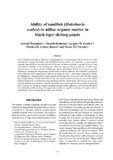Ability of sandfish (Holothuria scabra) to utilise organic matter in black tiger shrimp ponds
Share
抄録
Due to frequent viral disease outbreaks, a large proportion of shrimp aquaculture in South-East Asian countries has switched from black tiger shrimp (Penaeus monodon) to P. vannamei, an exotic species originally imported from Latin America. One of the causes of disease outbreaks is thought to be poor water and sediment conditions in the shrimp ponds, which may aggravate disease symptoms. To obtain basic information for co-culture methods of black tiger shrimp and sandfish (Holothuria scabra) for possible mitigation of shrimp-pond eutrophication and prevention of disease outbreaks, basic laboratory experiments were conducted at the Southeast Asian Fisheries Development Center—Aquaculture Department in Iloilo, the Philippines. A feeding trial of juvenile sandfish showed that they do not grow well with fresh shrimp feed on hard substrate. Another trial indicated that sand substrate enhances the growth of juvenile sandfish fed with shrimp feed. A feeding trial using shrimp tank detritus, shrimp faeces and Navicula ramosissima (a benthic diatom) as food sources showed that sandfish grew fastest with the faeces, followed by detritus and N. ramosissima. Dissolved oxygen consumption and acid-volatile sulfur levels in the shrimp tank detritus were reduced by sandfish feeding. This suggests that sandfish are capable of growing with organic matter in shrimp ponds, and can bioremediate shrimp-pond sediment.
Suggested Citation
Watanabe, S., Kodama, M., Zarate, J. M., Lebata-Ramos, M. J. H., & Nievales, M. F. J. (2012). Ability of sandfish (Holothuria scabra) to utilise organic matter in black tiger shrimp ponds. In C. A. Hair, T. D. Pickering, & D. J. Mills (Eds.), Asia-Pacific tropical sea cucumber aquaculture. Proceedings of an international symposium held in Noumea, New Caledonia, 15-17 February 2011 (ACIAR Proceedings No. 136) (pp. 113-120). Canberra, ACT: Australian Centre for International Agricultural Research.

